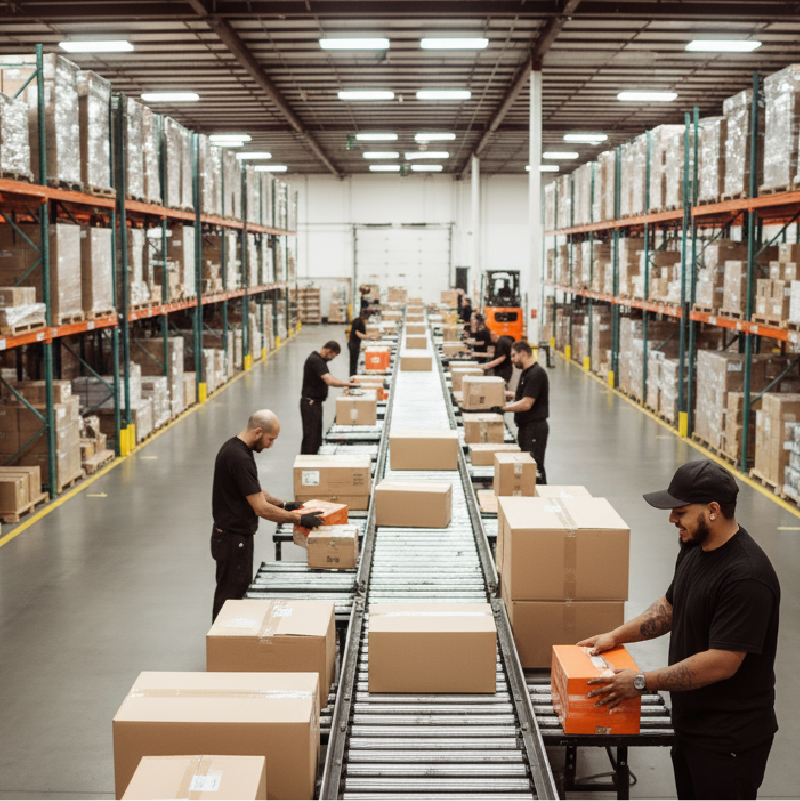The alarm bells stopped ringing three years ago after the chaos of COVID calmed. Forward-thinking supply chain leaders recognized AI as the competitive differentiator that would separate industry leaders from the rest.
Today, those leaders are banking real returns. Organizations implementing AI in their supply chains see transformational results, with 67% of companies reporting revenue increases from AI in supply chain and inventory management—one of the highest rates across all business functions, according to McKinsey research.
While others debate AI’s potential, growth-focused supply chain leaders are already banking real returns, with 46% having already implemented it in their supply chains.
What AI Really Means for Warehouses
Strip away the marketing jargon: AI in warehouse management enables faster, more informed decisions – the ability to review millions of consumer transactions and shipments rooted in real data vs. static reports or educated guesses.
The transformation happens in three critical areas:
Operational Intelligence eliminates the costly guesswork that plagues manual operations. While traditional warehouses waste 30% of worker time hunting for inventory, AI warehouse management systems identify these productivity drains and eliminate them. In a 100,000-square-foot facility, this alone recovers over $200,000 annually.
Predictive Capability shifts operations from reactive firefighting to proactive optimization. AI-powered WMS systems predict equipment failures and demand spikes weeks in advance, automatically preparing solutions.
Adaptive Learning ensures performance improvements compound over time. Every transaction teaches the system something new about demand patterns, optimal routes, and resource allocation.
Key AI Technologies Transforming Warehouses
Machine Learning for Demand Forecasting
Machine Learning (ML) has become the forgotten AI component. ML can be categorized as algorithms that analyze hundreds of variables simultaneously—cycle times, ordering patterns, social trends, local sales events—to predict demand with unprecedented accuracy. This has been a key underlying feature in supply chain planning and order routing. In modern AI tech stacks, it is used to predict events that are then fed as trusted business context into more advanced AI models.
Computer Vision for Inventory Management
Cameras and sensors provide continuous inventory verification without stopping operations. Products arriving at the dock are instantly identified, measured, and quality-checked without human intervention. Using sensors, both fixed and drone-based, AI is used to identify and count inventory as it is picked and replenished, reducing labor requirements. This feature set is generally integrated as Materials Handling Equipment (MHE) that provides the inventory updates directly to the WMS as if a human was entering it into a handheld as part of the cycle counting process.
Intelligent Robotics
Autonomous Mobile Robots (AMRs) powered by AI think, adapt, and collaborate with human workers. They calculate optimal paths in real-time, avoid congestion, and proactively schedule their own maintenance. In this use case, AI is used as a real-time coordinator for the work being released to the robots as well as a dynamic wayfinder for determining the best path to either bring goods to the operator or travel around the warehouse with resources in a co-bot environment where the robot acts as a helping hand to the picking resource.
Integrated AI Platforms
Organizations seeing 2-3x higher ROI understand that AI’s real power comes from integration across all warehouse functions. When inventory management, robotics, predictive maintenance, and workforce planning all communicate, results multiply exponentially because AI has more context in which to determine the best course of action. Based on the ever-changing environment in a warehouse, what is the next best task to accomplish? The more context you can provide AI, the more tailored the answer will be.
Measurable Results Leaders Are Achieving
The warehouses leading this transformation achieve breakthrough performance:
- 40% improvement in order fulfillment speed through intelligent routing
- 95%+ inventory accuracy maintained continuously without stopping operations
- 30% reduction in operational costs through predictive maintenance
- 30-minute new employee onboarding
The ROI of AI Warehouse Management Tech
Organizations implementing unified AI platforms typically see payback periods of six to 18 months, with leading solutions often delivering returns in under six months. The results are not what takes time, part of the delay in value realization is building enough clean data to provide context for the optimization and generative AI assistants. Some areas impacted by AI:
- Cost reduction occurs through multiple channels: labor productivity gains of 30-50% through better planning and allocation, shipping optimization that cuts freight costs by 15-25% from volume discounts and inventory locationing, as well as accuracy improvements from better order management that eliminates expensive returns. These savings are just a few that can be realized and compound year over year.
- Revenue enhancement stems from improvements in customer experience and satisfaction, that is reflected in CSAT scores. Perfect order rates above 99%, faster cycle times, and proactive communication and visibility turn fulfillment from a cost center into a competitive differentiator.
- Scalability becomes effortless when AI handles complexity. AI-powered warehouse management operations adapt automatically, handling volume increases without proportional cost increases. When you provide the context necessary for AI to deliver waving, routing, or other sequencing and processing improvements, the same resources can accomplish more.
The Competitive Reality
AI in warehouse management has become essential. The gap between AI-powered and traditional warehouses widens daily. Speed, accuracy, efficiency, and adaptability advantages compound over time, creating competitive moats that deepen with every passing month.
The organizations winning today started their AI journey with a clear commitment to transformation. They understood that standing still while the world moves forward poses the most significant risk.
Your Path Forward
The warehouse of the future has arrived. Your warehouse chaos can become clarity. Your operational challenges can become competitive advantages.
The transformation requires choosing platforms that deliver genuine intelligence rather than expensive automation dressed up as AI. The tools are proven. The results are measurable. The time is now.
